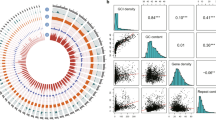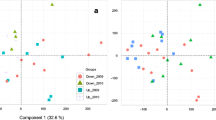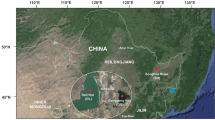Abstract
Pollution can drive rapid evolutionary change in wild populations. This study targets functional polymorphisms of chronically metal-contaminated wild yellow perch (Perca flavescens). A de novo transcriptome scan contrasted subsets of individuals from clean (n = 16) and contaminated (n = 16) lakes to identify 87 candidate annotated coding SNPs. Candidate genotypes and liver [metal] were obtained in 10 populations (n = 1,052) and a genome scan distinguished outliers: one nuclear (cyclin G1 gene) and two mitochondrial (cytochrome b and NADH dehydrogenase subunit 2 genes) also displaying allelic correlation to mean population [cadmium]. Whole mtDNA and 17 kb surrounding cyclin G1 were characterised through 454 sequencing thus revealing two non-synonymous substitutions involving dissimilar amino acids. Based on associated functions and inter-population differentiation, contaminated perch may have been selected for fast life cycle completion (p53 pathway) and memorization impairment mitigation (long-term potentiation pathway). In accordance with predicted evolutionary trajectory for stressed and energy deprived organisms, adapted perch would not compensate for repair mechanism inhibition, instead reallocating energy towards growth and favouring inexpensive impairment mitigation adaptations over costly detoxification. Overall, 85 years of selection could have driven rapid, potentially adaptive evolution by selecting alleles increasing perch fitness in polluted environments.





Similar content being viewed by others
References
Akimoto H (2003) Global air quality and pollution. Science 302:1716–1719
Ali DW, Salter MW (2001) NMDA receptor regulation by Src kinase signalling in excitatory synaptic transmission and plasticity. Curr Opin Neurobiol 11:336–342
Angilletta MJ, Steel EA, Bartz KK, Kingsolver JG, Scheuerell MD, Beckman BR, Crozier LG (2008) Big dams and salmon evolution: changes in thermal regimes and their potential evolutionary consequences. Evol Appl 1:286–299
Barrett RDH, Schluter D (2008) Adaptation from standing genetic variation. Trends Ecol Evol 23:38–44
Beaumont MA, Nichols RA (1996) Evaluating loci for use in the genetic analysis of population structure. Proc R Soc Lond Ser B Biol Sci 263:1619–1626
Bourret V, Couture P, Campbell PG, Bernatchez L (2008) Evolutionary ecotoxicology of wild yellow perch (Perca flavescens) populations chronically exposed to a polymetallic gradient. Aquat Toxicol 86:76–90
Brockman W, Alvarez P, Young S, Garber M, Giannoukos G, Lee WL, Russ C, Lander ES, Nusbaum C, Jaffe DB (2008) Quality scores and SNP detection in sequencing-by-synthesis systems. Genome Res 18:763–770
Burge C, Karlin S (1997) Prediction of complete gene structures in human genomic DNA. J Mol Biol 268:78–94
Campbell PGC, Giguere A, Bonneris E, Hare L (2005) Cadmium-handling strategies in two chronically exposed indigenous freshwater organisms—the yellow perch (Perca flavescens) and the floater mollusc (Pyganodon grandis). Aquat Toxicol 72:83–97
Cattaneo A, Couillard Y, Wunsam S (2008) Sedimentary diatoms along a temporal and spatial gradient of metal contamination. J Paleolimnol 40:115–127
Chapman PM (2002) Integrating toxicology and ecology: putting the “eco” into ecotoxicology. Marine Pollut Bull 44:7–15
Chin D, Means AR (2000) Calmodulin: a prototypical calcium sensor. Trends Cell Biol 10:322–328
Cohen P (2000) The regulation of protein function by multisite phosphorylation—a 25 year update. Trends Biochem Sci 25:596–601
Couillard Y, Courcelles M, Cattaneo A, Wunsam S (2004) A test of the integrity of metal records in sediment cores based on the documented history of metal contamination in Lac Dufault (Quebec, Canada). J Paleolimnol 32:149–162
Couture P, Pyle G (2008) Live fast and die young: metal effects on condition and physiology of wild yellow perch from along two metal contamination gradients. Hum Ecol Risk Assess Int J 14:73–96
Couture P, Rajotte JW, Pyle GG (2008a) Seasonal and regional variations in metal contamination and condition indicators in yellow perch (Perca flavescens) along two polymetallic gradients. III. Energetic and physiological indicators. Hum Ecol Risk Assess 14:146–165
Couture P, Busby P, Gauthier C, Rajotte JW, Pyle GG (2008b) Seasonal and regional variations of metal contamination and condition indicators in yellow perch (Perca flavescens) along two polymetallic gradients. I. Factors influencing tissue metal concentrations. Hum Ecol Risk Assess 14:97–125
Excoffier L, Lischer HEL (2010) Arlequin suite ver 3.5: a new series of programs to perform population genetics analyses under Linux and Windows. Mol Ecol Resour 10:564–567
Felsenstein J (1976) Theoretical population-genetics of variable selection and migration. Annu Rev Genet 10:253–280
Flicek P et al (2012) Ensembl 2012. Nucleic Acids Res 40:D84–D90
Foll M, Gaggiotti O (2008) A genome-scan method to identify selected loci appropriate for both dominant and codominant markers: a Bayesian Perspective. Genetics 180:977–993
Giguere A, Campbell PGC, Hare L, McDonald DG, Rasmussen JB (2004) Influence of lake chemistry and fish age on cadmium, copper, and zinc concentrations in various organs of indigenous yellow perch (Perca flavescens). Can J Fish Aquat Sci 61:1702–1716
Gingrich JR, Pelkey KA, Fam SR, Huang YQ, Petralia RS, Wenthold RJ, Salter MW (2004) Unique domain anchoring of Src to synaptic NMDA receptors via the mitochondrial protein NADH dehydrogenase subunit 2. Proc Natl Acad Sci USA 101:6237–6242
Guo SW, Thompson EA (1992) Performing the exact test of Hardy–Weinberg Proportion for Multiple Alleles. Biometrics 48:361–372
Harris SL, Levine AJ (2005) The p53 pathway: positive and negative feedback loops. Oncogene 24:2899–2908
Hendry AP, Kinnison MT (2001) An introduction to microevolution: rate, pattern, process. Genetica 112–113:1–8
Jacobsen MW, Hansen MM, Orlando L, Bekkevold D, Bernatchez L, Willerslev E, Gilbert MTP (2012) Mitogenome sequencing reveals shallow evolutionary histories and recent divergence time between morphologically and ecologically distinct European whitefish (Coregonus spp.). Mol Ecol 21:2727–2742
Jeffreys HS (1961) Theory of probability/by Harold Jeffreys. Clarendon Press, Oxford
Joost S, Bonin A, Bruford MW, Despres L, Conord C, Erhardt G, Taberlet P (2007) A spatial analysis method (SAM) to detect candidate loci for selection: towards a landscape genomics approach to adaptation. Mol Ecol 16:3955–3969
Kandel ER (2001) The molecular biology of memory storage: a dialogue between genes and synapses. Science 294:1030–1038
Kim MS, Kim BJ, Woo HN, Kim KW, Kim KB, Kim IK, Jung YK (2000) Cadmium induces caspase-mediated cell death: suppression by Bcl-2. Toxicology 145:27–37
Kosinski J, Cymerman IA, Feder M, Kurowski MA, Sasin JM, Bujnicki JM (2003) A “Frankenstein’s monster” approach to comparative modeling: merging the finest fragments of fold-recognition models and iterative model refinement aided by 3D structure evaluation. Proteins Struct Funct Bioinform 53:369–379
Kovecses J, Sherwood GD, Rasmussen JB (2005) Impacts of altered benthic invertebrate communities on the feeding ecology of yellow perch (Perca flavescens) in metal-contaminated lakes. Can J Fish Aquat Sci 62:153–162
Kurowski MA, Bujnicki JM (2003) GeneSilico protein structure prediction meta-server. Nucleic Acids Res 31:3305–3307
Kyte J, Doolittle RF (1982) A simple method for displaying the hydropathic character of a protein. J Mol Biol 157:105–132
Li H, Handsaker B, Wysoker A, Fennell T, Ruan J, Homer N, Marth G, Abecasis G, Durbin R, Proc GPD (2009) The sequence alignment/map format and SAMtools. Bioinformatics 25:2078–2079
Loman NJ, Misra RV, Dallman TJ, Constantinidou C, Gharbia SE, Wain J, Pallen MJ (2012) Performance comparison of benchtop high-throughput sequencing platforms. Nat Biotechnol 30:434–439
Lovell SC, Davis IW, Adrendall WB, de Bakker PIW, Word JM, Prisant MG, Richardson JS, Richardson DC (2003) Structure validation by C alpha geometry: phi, psi and C beta deviation. Proteins Struct Funct Genet 50:437–450
Margulies M et al (2005) Genome sequencing in microfabricated high-density picolitre reactors. Nature 437:376–380
Mayer ML, Vyklicky L, Westbrook GL (1989) Modulation of excitatory amino-acid receptors by group IIB metal-cations in cultured mouse Hippocampal-neurons. J Physiol Lond 415:329–350
Medina MH, Correa JA, Barata C (2007) Micro-evolution due to pollution: possible consequences for ecosystem responses to toxic stress. Chemosphere 67:2105–2114
Meplan C, Mann K, Hainaut P (1999) Cadmium induces conformational modifications of wild-type p53 and suppresses p53 response to DNA damage in cultured cells. J Biol Chem 274:31663–31670
Nakazawa K, McHugh TJ, Wilson MA, Tonegawa S (2004) NMDA receptors, place cells and hippocampal spatial memory. Nat Rev Neurosci 5:361–372
Ohtsuka T, Ryu H, Minamishima YA, Ryo A, Lee SW (2003) Modulation of p53 and p73 levels by cyclin G: implication of a negative feedback regulation. Oncogene 22:1678–1687
Ohtsuka T, Jensen MR, Kim HG, Kim KT, Lee SW (2004) The negative role of cyclin G in ATM-dependent p53 activation. Oncogene 23:5405–5408
Okamoto K, Li H, Jensen MR, Zhang T, Taya Y, Thorgeirsson SS, Prives C (2002) Cyclin G recruits PP2A to dephosphorylate Mdm2. Mol Cell 9:761–771
Patterson N, Price AL, Reich D (2006) Population structure and eigenanalysis. PLoS Genet 2:2074–2093
Perceval O, Couillard Y, Pinel-Alloul B, Campbell PGC (2006) Linking changes in subcellular cadmium distribution to growth and mortality rates in transplanted freshwater bivalves (Pyganodon grandis). Aquat Toxicol 79:87–98
Pierron F, Bourret V, St-Cyr J, Campbell PG, Bernatchez L, Couture P (2009) Transcriptional responses to environmental metal exposure in wild yellow perch (Perca flavescens) collected in lakes with differing environmental metal concentrations (Cd, Cu, Ni). Ecotoxicology 18:620–631
Pierron F, Couture P, Normandeau E, Defo MA, Campbell PGC, Bernatchez L (2011) Effects of chronic metal exposure on wild fish populations revealed by high-throughput cDNA sequencing. Ecotoxicology 20:1388–1399
Piscopo DM, Hinds PW (2008) A role for the cyclin box in the ubiquitin-mediated degradation of cyclin G1. Cancer Res 68:5581–5590
Portales-Casamar E, Thongjuea S, Kwon AT, Arenillas D, Zhao XB, Valen E, Yusuf D, Lenhard B, Wasserman WW, Sandelin A (2010) JASPAR 2010: the greatly expanded open-access database of transcription factor binding profiles. Nucleic Acids Res 38:D105–D110
Posthuma L, van Straalen NM (1993) Heavy-metal adaptation in terrestrial invertebrates—a review of occurrence, genetics, physiology and ecological consequences. Comp Biochem Physiol C Pharmacol Toxicol Endocrinol 106:11–38
Pra D, Franke SIR, Giulian R, Yoneama ML, Dias JF, Erdtmann B, Henriques JAP (2008) Genotoxicity and mutagenicity of iron and copper in mice. Biometals 21:289–297
Price AL, Patterson NJ, Plenge RM, Weinblatt ME, Shadick NA, Reich D (2006) Principal components analysis corrects for stratification in genome-wide association studies. Nat Genet 38:904–909
Pruitt KD, Tatusova T, Klimke W, Maglott DR (2009) NCBI Reference Sequences: current status, policy and new initiatives. Nucleic Acids Res 37:D32–D36
Pyle G, Busby P, Gauthier C, Rajotte J, Couture P (2008) Seasonal and regional variations in metal contamination and condition indicators in yellow perch (Perca flavescens) along two polymetallic gradients. II. Growth patterns, longevity, and condition. Hum Ecol Risk Assess 14:126–145
Raymond M, Rousset F (1995) GENEPOP (Version 1.2): population genetics software for exact tests and ecumenicism. J Hered 86:248–249
Reich D et al (2008) Long-range LD can confound genome scans in admixed populations. Am J Hum Genet 83:132–135
Reznick DN, Ghalambor CK (2001) The population ecology of contemporary adaptations: what empirical studies reveal about the conditions that promote adaptive evolution. Genetica 112–113:183–198
Rokas A, Abbot P (2009) Harnessing genomics for evolutionary insights. Trends Ecol Evol 24:192–200
Rozen S, Skaletsky H (2000) Primer3 on the WWW for general users and for biologist programmers. Methods Mol Biol 132:365–386
Sandelin A, Wasserman WW, Lenhard B (2004) ConSite: web-based prediction of regulatory elements using cross-species comparison. Nucleic Acids Res 32:W249–W252
Sauvage C, Vagner M, Derome N, Audet C, Bernatchez L (2012) Coding gene single nucleotide polymorphism mapping and quantitative trait loci detection for physiological reproductive traits in Brook Charr, Salvelinus fontinalis. G3 (Bethesda) 2:379–392
Schiller J, Schiller Y, Clapham DE (1998) NMDA receptors amplify calcium influx into dendritic spines during associative pre- and post-synaptic activation. Nat Neurosci 1:114–118
Schrodinger, LLC. 2010. The PyMOL Molecular Graphics System, Version 1.3
Schwerdtle T, Ebert F, Thuy C, Richter C, Mullenders LHF, Hartwig A (2010) Genotoxicity of soluble and particulate cadmium compounds: impact on oxidative DNA damage and nucleotide excision repair. Chem Res Toxicol 23:432–442
Sepulveda-Villet OJ, Ford AM, Williams JD, Stepien CA (2009) Population genetic diversity and phylogeographic divergence patterns of the yellow perch (Perca flavescens). J Great Lake Res 35:107–119
Shah J, Pant HC (1991) Effect of cadmium on Ca2+ transport in brain microsomes. Brain Res 566:127–130
Sherwood GD, Kovecses J, Hontela A, Rasmussen JB (2002) Simplified food webs lead to energetic bottlenecks in polluted lakes. Can J Fish Aquat Sci 59:1–5
Shimizu E, Tang YP, Rampon C, Tsien JZ (2000) NMDA receptor-dependent synaptic reinforcement as a crucial process for memory consolidation. Science 290:1170–1174
Sibly RM, Calow P (1989) A life-cycle theory of responses to stress. Biol J Linn Soc 37:101–116
Sloss BL, Billington N, Burr BM (2004) A molecular phylogeny of the Percidae (Teleostei, Perciformes) based on mitochondrial DNA sequence. Mol Phylogenet Evol 32:545–562
Smith TB, Bernatchez L (2008) Evolutionary change in human-altered environments. Mol Ecol 17:1–8
Snyder MJ (2000) Cytochrome P450 enzymes in aquatic invertebrates: recent advances and future directions. Aquat Toxicol 48:529–547
Tamura K, Peterson D, Peterson N, Stecher G, Nei M, Kumar S (2011) MEGA5: molecular evolutionary genetics analysis using maximum likelihood, evolutionary distance, and maximum parsimony methods. Mol Biol Evol 28:2731–2739
Tobler M, Culumber ZW, Plath M, Winemiller KO, Rosenthal GG (2010) An indigenous religious ritual selects for resistance to a toxicant in a livebearing fish. Biol Lett 7(2):229–232
van Straalen NM, Feder ME (2012) Ecological and evolutionary functional genomics—how can it contribute to the risk assessment of chemicals? Environ Sci Technol 46:3–9
van Straalen NM, Timmermans MJTN (2002) Genetic variation in toxicant-stressed populations: an evaluation of the “genetic erosion” hypothesis. Hum Ecol Risk Assess 8:983–1002
Vig PJS, Bhatia M, Gill KD, Nath R (1989) Cadmium inhibits brain calmodulin—invitro and invivo studies. Bull Environ Contam Toxicol 43:541–547
Vig PJS, Ravi K, Nath R (1991) Interaction of metals with brain calmodulin purified from normal and cadmium exposed rats. Drug Chem Toxicol 14:207–218
Vitousek PM, Mooney HA, Lubchenco J, Melillo JM (1997) Human domination of Earth’s ecosystems. Science 277:494–499
Williams LM, Oleksiak MF (2011) Evolutionary and functional analyses of cytochrome P4501A promoter polymorphisms in natural populations. Mol Ecol 20:5236–5247
Wimley WC, Creamer TP, White SH (1996) Solvation energies of amino acid side chains and backbone in a family of host-guest pentapeptides. Biochemistry 35:5109–5124
Zhao L, Samuels T, Winckler S, Korgaonkar C, Tompkins V, Horne MC, Quelle DE (2003) Cyclin G1 has growth inhibitory activity linked to the ARF-Mdm2-p53 and pRb tumor suppressor pathways. Mol Cancer Res 1:195–206
Acknowledgments
We would like to thank all members of the yellow perch project team from P.C. and L.B. laboratories and, more specifically : J. Grasset, F. Lamaze, E. Normandeau, B. Bougas, F. Pierron, C. Perrier, P.-A. Gagnaire, H. Maaroufi, B. Boyle, 755 S. Larose, J. Laroche, S. Pavey, G. Ouellet-Cauchon, G. Côté, C. Tingaud, D. Ferguson, L. Papillon, as well as M. Dutton (Vale Ltd) for his valuable inputs. We are grateful for the services of IBIS’s genomic analysis platform (http://pag.ibis.ulaval.ca/seq/fr/), which was responsible for the 454 sequencing and associated troubleshooting. We also acknowledge the suggestions for improvement received from V. Bourret for this article. Finally, we thank Associate editor Lee Raleigh Shugart and two anonymous referees for their constructive inputs. This work was funded by a Collaborative Research and Development (CRD) Grant (CRDPJ 379611-08) mutually funded by the Natural Sciences and Engineering Research Council (NSERC) of Canada and by Vale Ltd. The Canada Research Chair program supports LB and PGCC.
Ethical standards
All experiments comply with current Canadian law for animal research and testing.
Conflict of interest
The authors declare no other conflict of interest.
Author information
Authors and Affiliations
Corresponding author
Electronic supplementary material
Below is the link to the electronic supplementary material.
Rights and permissions
About this article
Cite this article
Bélanger-Deschênes, S., Couture, P., Campbell, P.G.C. et al. Evolutionary change driven by metal exposure as revealed by coding SNP genome scan in wild yellow perch (Perca flavescens). Ecotoxicology 22, 938–957 (2013). https://doi.org/10.1007/s10646-013-1083-8
Accepted:
Published:
Issue Date:
DOI: https://doi.org/10.1007/s10646-013-1083-8




